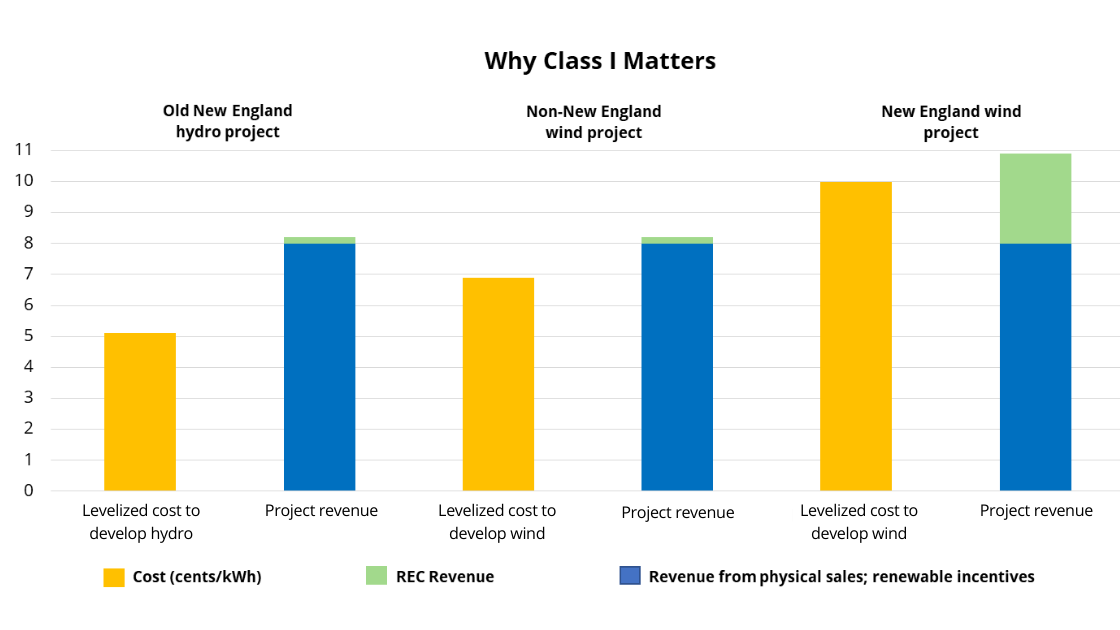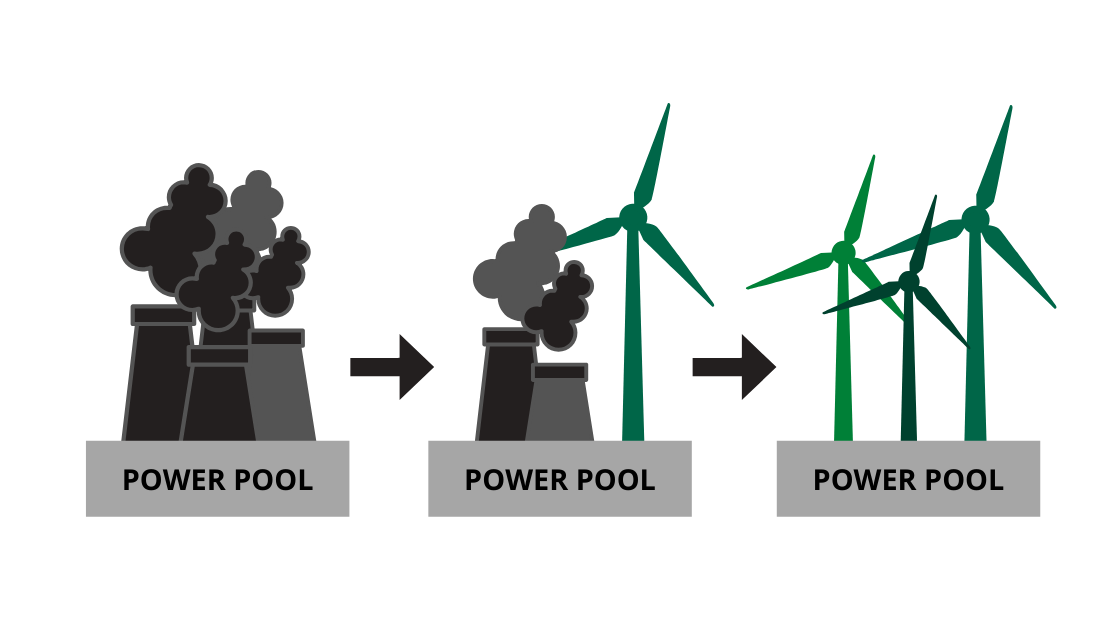It starts with Renewable Energy Certificates
When you make the switch to green electricity through Green Energy Consumers' Green Powered or through a Community Choice Electricity program that works with us, we purchase renewable energy certificates (RECs) on your behalf. Owning and retiring RECs for the energy you consume is the only way to claim that your electricity came from renewable energy sources.
For every megawatt hour (MWh) of electricity that a renewable energy generator puts on the grid, a REC is created.
Each certificate documents the characteristics of the power source, information such as air emissions, fuel source, generation date, and date the generator began operating.
RECs represent and can be sold separately from electrons. Purchases and sales of RECs in New England tracked are tracked in the NEPOOL Generation Information System. By allowing people to purchase renewable energy instead of having to install it on their homes, and thereby providing an extra stream of funding for renewable energy projects, the specifically Class I or “new” REC market has driven the development of more renewable energy in New England.
Why do you need to buy RECs to claim you're green powered?
The electric grid is like a bathtub with spigots feeding into it (generators) and streams draining out of it (electricity users). There’s no way of knowing which generator produced the specific electrons that power your home, just as there’s no way of knowing exactly which stream a specific water droplet came from once it’s in a bathtub. diagram That’s where RECs come in: 1 REC symbolizes a specific megawatt-hour of electricity created by a renewable energy generator, and represents a claim to it. By buying the REC, you are claiming that particular renewable energy for your home. If you buy Class I or “new” RECs, you’re also sending a message to the “spigots” to add more renewable energy and less fossil fuels to the overall grid.
We’ll explain that next.
Class I & state clean energy laws

Supplying our members with Renewable Energy Certificates that make a difference on the New England power grid is key to our non-profit mission, so Green Powered supplies only “Class I” or “new” RECs.
In Massachusetts and Rhode Island, different kinds of RECs are separated into classes defined in each state's renewable energy laws (the Massachusetts Renewable Energy Portfolio Standard (RPS) and the Rhode Island Renewable Energy Standard).
“Class I” or “new” RECs come from specific types of New England renewable energy generators built since 1997.
Per the laws, all electricity suppliers (such as the major utilities, Eversource and National Grid) must source an increasing amount of their electric load from Class I projects every year. By purchasing Class I/new RECs and only Class I/new RECs, someone like you can push the grid towards a greener future faster. The more we buy voluntarily, the greater the demand from major electricity suppliers to fulfill the mandate (sometimes we call it “keepaway”), and the more projects will get built.

Beware bogus green electricity suppliers
We are a renewable energy certificate supplier for the public good. We do not supply electrons, as competitive electricity suppliers do. We are not a competitive electricity supplier, but we are often confused with them. Here’s what makes us different, and why you should be on your guard when solicited by competitive suppliers.
Competitive suppliers purchase electrons on your behalf and often promise savings compared to what the utility supplies, but these savings do not last. It has been proven that individual consumers lose money overall when they choose a competitive supplier.
- In Massachusetts, a study by AG Healey found that consumers paid $426 million more on electricity than necessary between 2016 and 2021. Low-income consumers are twice as likely to pay these higher bills than other customers.
- Customers of National Grid in Rhode Island who chose an electricity supplier on their own paid a much higher average rate; approximately $200 per year on average when compared to those who stayed on the utility’s Standard Offer.
Many competitive suppliers have been known to “greenwash”, which is to market a product claiming it’s great for the environment when it’s not. When you buy green electricity, you want this to happen.

But unless you buy Class I/new, it doesn't. You are just buying RECs to line someone's pockets. Some non-Class-I RECs come from projects in New England that were built before 1997 (before the RPS and the creation of the REC system in New England). The majority, however, come from projects across the country and get sold on the national market. Most RECs on the national market come from projects in places with weak state mandates or the natural conditions that make renewable energy projects financially feasible even without the revenue from REC sales.
Because of these different conditions, RECs from places like Texas (for example) are overabundant and cheaper than New England RECs; supply has outstripped demand. Many competitive suppliers have taken advantage of this situation, claiming to offer a “green” product but most likely purchasing cheap RECs on the national market and marking them up handsomely. By law, competitive suppliers will include the minimum Class I/new renewable energy required, but that’s all.
You get what you pay for. A “green” competitive supplier may cost less than Green Powered, but almost every penny paid to Green Powered goes toward purchasing RECs from local projects in need of financial support.
We’re careful to only supply Class I/new renewable energy through Green Powered. Over the years, members have made renewable energy projects happen.